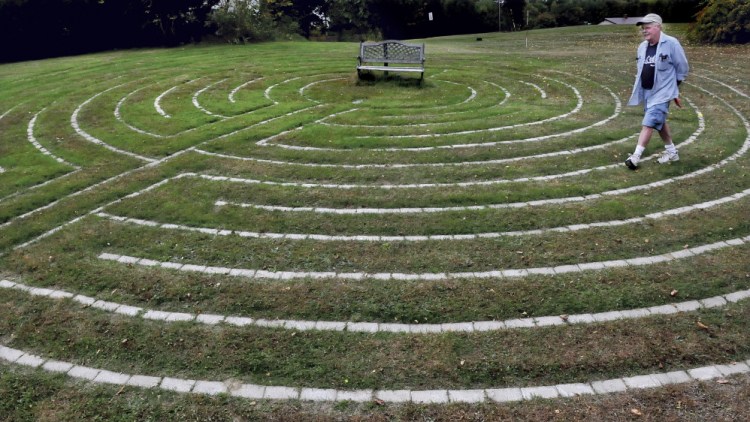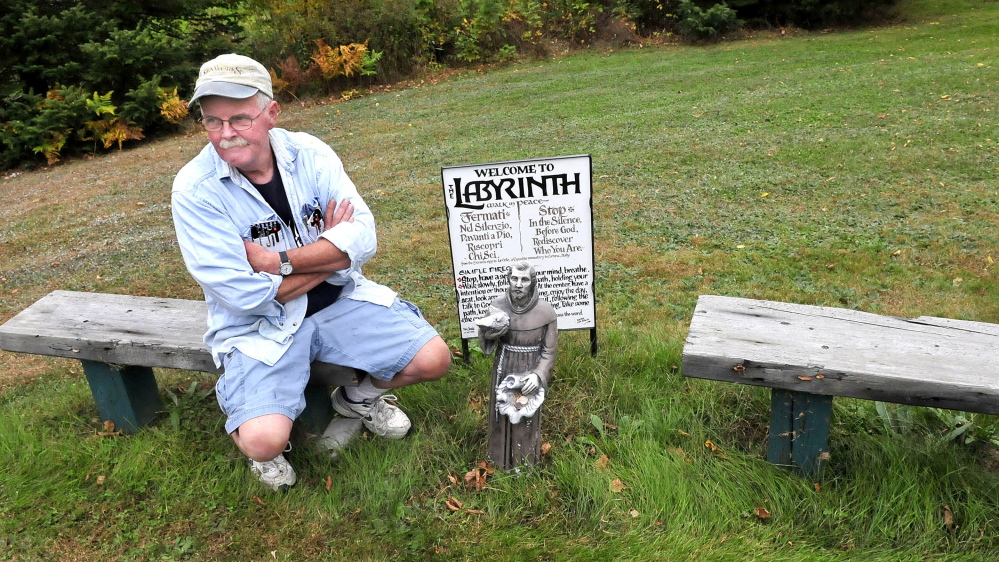FARMINGTON — Mike Monahan said people aren’t always quite sure what to do with the 55 foot public labyrinth he built in his backyard.
They’re sometimes expecting something more like a corn maze, and it can take a while for some to realize the winding brick path they’re standing on is the labyrinth. They’re not always sure what to do.
So Monahan, the gruff, straightforward owner of Sign Works in Farmington, added a straightforward sign with directions near the entrance to the path:
1. Stop and have a seat, clear you mind, breathe.
2. Walk slowly, following the path, holding your intention or thought (or not).
3. At the center have a seat, look around, keep breathing, enjoy the day, talk to God, whatever.
4. Walk out, following the path, keep listening, keep breathing. Take some of the energy with you.
Labyrinths, unlike mazes, aren’t meant to trick the user or have false turns. Instead, the 613 Fairbanks Road labyrinth is part of a 20 year trend of revival of the use of labyrinths as a way to focus in meditation. There’s one path that leads to the center and one path that leads out, and the walker follows the path while quietly thinking.
“It’s whatever you want it to mean. It’s a way to get away from it all and breathe,” he said. “I’m not here to tell you how to do it.”
While labyrinths have been around for about 4000 years, use of the winding, circular pathways was revived about 20 years ago by Lauren Artress, who runs a Californian nonprofit to promote their use as a community building tool.
“It had been dormant for a while and she brought it back. People walk this path and seem to really resonate with it,” said Beth Burnham Mace, president of the Labyrinth Guild of New England. “And as a result people have been inspired to bring this path into all sorts of social settings.”
Mace said their organization, started about 15 years ago, encourages the use of labyrinths as a meditative tool in places like hospitals, schools and even two Massachusetts prisons.
She said people walk their own pace, sometimes pause in the middle and then follow the path back out.
“There’s no right or wrong way to walk a labyrinth,” she said.
But all the background and different interpretations some give to the meaning of labyrinths means little to Monahan. He said he is not trying to associate the labyrinth with a particular meaning.
He also said he tries not to associate it with a particular religion. Monahan himself identifies with Sufism – a mystical branch of Islam — but he invites area churches of various denominations and worded the language on his labyrinth directions to accommodate atheists and agnostics, as well as the devout.
“We all put the meaning on it that we want it to have. The whole trick is really to stop and think and breath,” he said.
When he first built the labyrinth five years ago, it started out with yellow nylon rope marking the path. The grass, however, quickly grew over the rope, so he switched to weed wacking the path. A year later, he installed bricks to outline the labyrinth pattern.
Laying down the hundreds of bricks was a meditative act in itself, said Monahan, thinking back on the laborious process.
At the center of the labyrinth, he placed a bench for meditation and planted a tree.
“What I can’t wait for is for 20 years from now when that tree has really grown,” he said.
He said that an alternative healing class at the University of Maine at Farmington annually takes a trip out to the site to learn about the labyrinth.
“I tell them they should come back when their dog dies, or husband leaves or the truck blows up. That’s when this thing will have real meaning for them.”
Kaitlin Schroeder — 861-9252
Send questions/comments to the editors.




Success. Please wait for the page to reload. If the page does not reload within 5 seconds, please refresh the page.
Enter your email and password to access comments.
Hi, to comment on stories you must . This profile is in addition to your subscription and website login.
Already have a commenting profile? .
Invalid username/password.
Please check your email to confirm and complete your registration.
Only subscribers are eligible to post comments. Please subscribe or login first for digital access. Here’s why.
Use the form below to reset your password. When you've submitted your account email, we will send an email with a reset code.